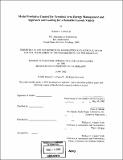Model predictive control for terminal area energy management and approach and landing for a reusable launch vehicle
Author(s)
LePome, Robert C. (Robert Charles), 1977-
DownloadFull printable version (9.414Mb)
Other Contributors
Massachusetts Institute of Technology. Dept. of Aeronautics and Astronautics.
Advisor
Piero A. Miotto and Wallace E. Vander Velde.
Terms of use
Metadata
Show full item recordAbstract
The space industry plans to develop new reusable launch vehicles. The new vehicles will need advanced, new guidance and control systems. Since 1996 Draper Laboratory has been developing the next generation guidance and control for reusable launch vehicles in which guidance and control is integrated into one correlated system. Draper's research of integrated guidance and control originated with a single loop multivariable control scheme using time-invariant linear quadratic regulator theory. The research has since evolved into the use of model predictive control theory. The main focus of this thesis is the theory and design of model predictive control for entry of aerospace vehicles. The goal is to develop design criteria and guidelines explaining how to select the model predictive control parameters: prediction horizon, simulation rates, and weighting matrices. A secondary goal is to tightly couple an onboard trajectory generation algorithm with the model predictive controller to improve tracking performance and robustness. Favorable tracking is achieved through two model predictive control architectures, which are discussed. The first architecture has an inner loop stability augmentation system with model predictive control used as an outer loop. The second architecture replaces the inner and outer loops with a single model predictive controller. The two architectures demonstrate the flexibility of model predictive control to adapt to new vehicles; the model predictive control may be used to augment an existing inner loop or may be used as a stand-alone controller. The design focuses primarily on the architecture without a stability augmentation system.
Description
Thesis (S.M.)--Massachusetts Institute of Technology, Dept. of Aeronautics and Astronautics, 2002. Includes bibliographical references (p. 235-236).
Date issued
2002Department
Massachusetts Institute of Technology. Department of Aeronautics and AstronauticsPublisher
Massachusetts Institute of Technology
Keywords
Aeronautics and Astronautics.